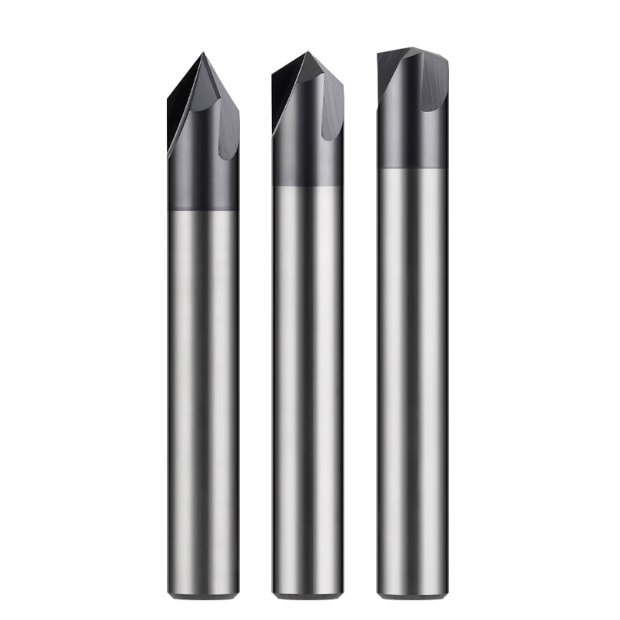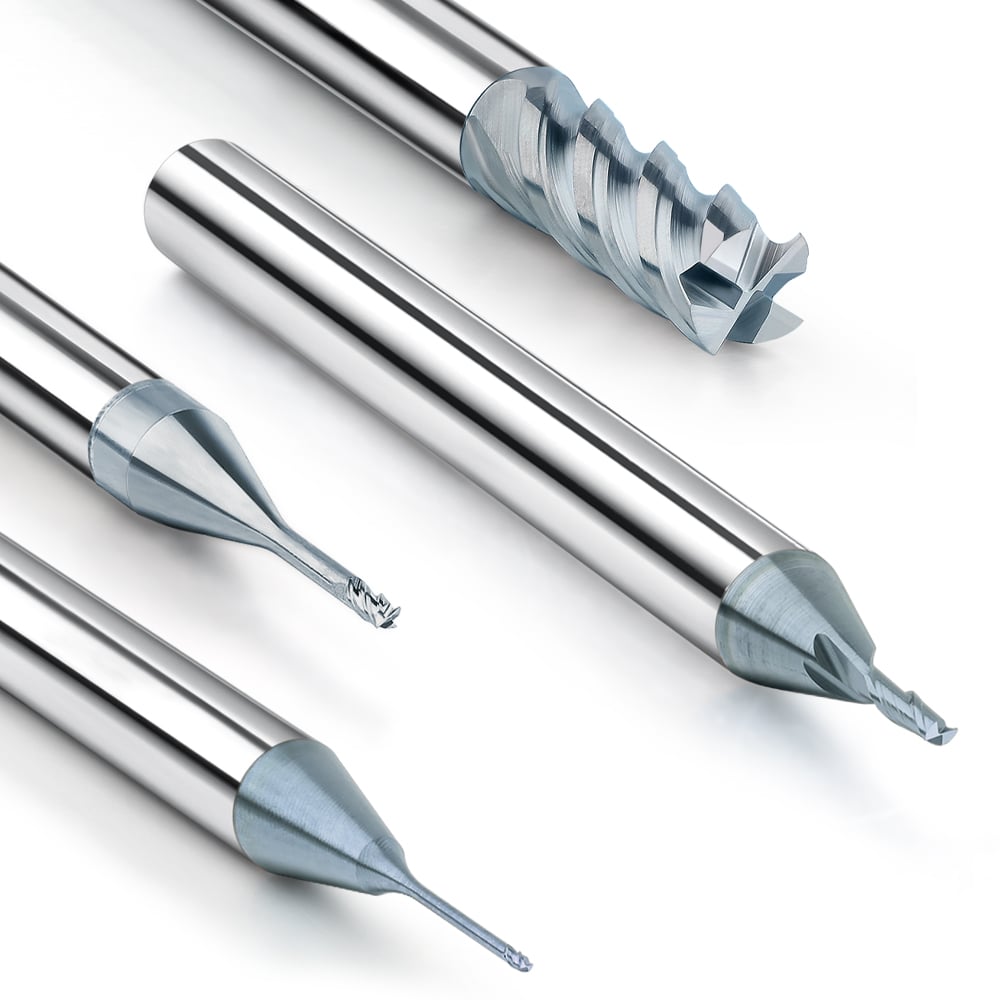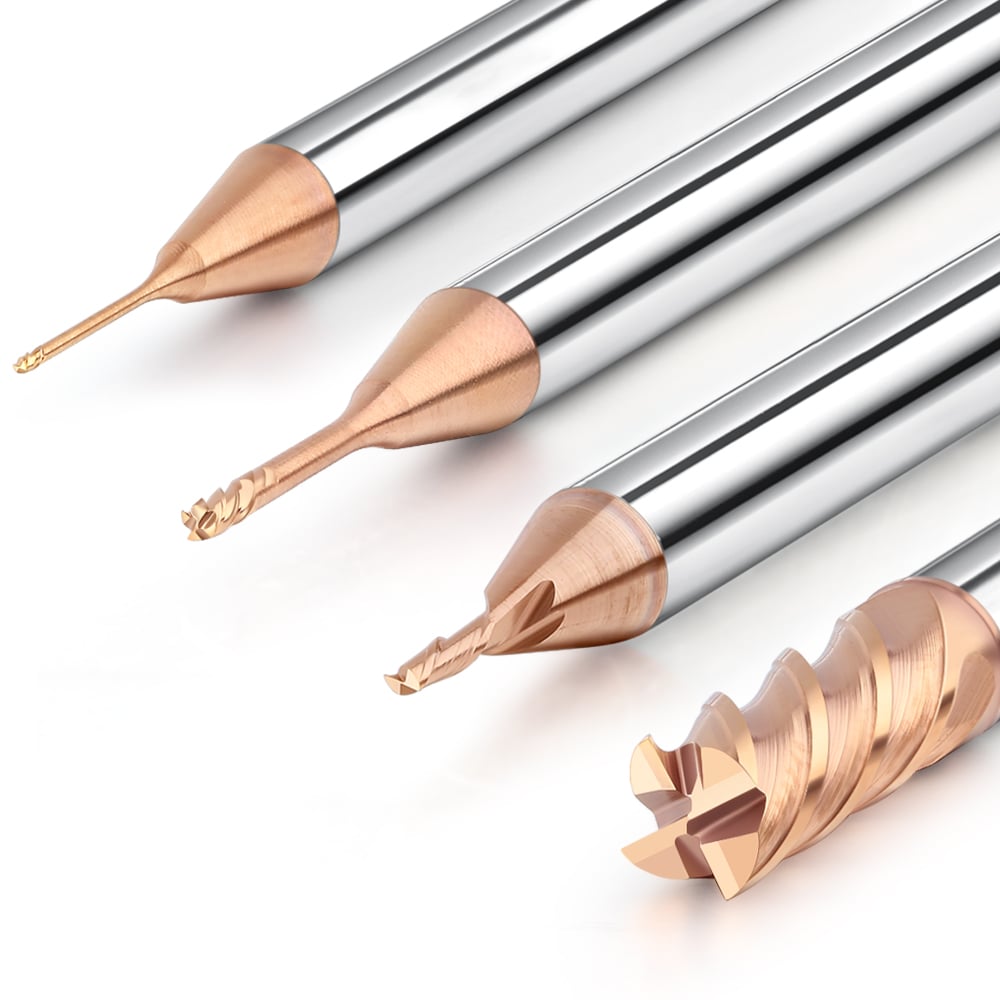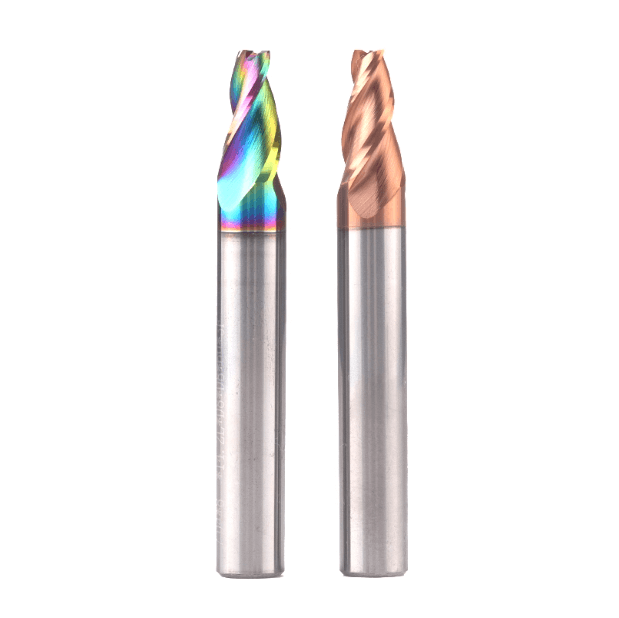High-speed machining places extremely high demands on milling tool performance, and end mill coatings play a decisive role in extending tool life, improving machining efficiency, and ensuring superior surface finish. Different types of end mill coatings not only influence wear resistance and thermal stability but also determine whether the tool is suitable for cutting aluminum, plastics, steel, stainless steel, or titanium alloys.
By selecting the right coating, CNC engineers can minimize cutting friction, reduce tool wear, and maintain high dimensional accuracy even under demanding cutting conditions. For example, end mill coatings for aluminum must prevent material adhesion, while coatings for titanium and stainless steel must withstand extreme heat and resist work hardening.
This article explores the fundamentals of end mill coatings, reviews the main coating types, and provides a material-specific selection guide. It also shares practical machining tips—such as cutting parameter optimization and tool maintenance—helping CNC engineers achieve both efficiency and precision in high-speed manufacturing.

Basic Knowledge of Milling Cutter Coatings
Milling cutter coatings form a protective, high-hardness layer on the tool surface that enhances wear resistance, thermal stability, and anti-sticking properties. With the right coating, tools not only last longer but also maintain high cutting efficiency and deliver better surface quality. This reduces downtime for tool changes and lowers overall machining costs.
Different coating materials and deposition processes deliver distinct advantages. In high-speed machining of aluminum, coatings prevent sticking and tool clogging. For stainless steel or titanium, coatings improve high-temperature resistance and durability. By understanding the performance characteristics of various coatings, CNC engineers can better match coatings with work materials and cutting conditions.
What Are End Mill Coatings?
End mill coatings are functional material layers applied to cutting tool substrates to enhance tool performance. They reduce cutting friction, protect against wear, and improve resistance to heat and chemical reactions. Common coatings include titanium nitride (TiN), titanium aluminum nitride (TiAlN), and diamond-based coatings.
With proper coating selection, CNC engineers can keep tools sharp, maintain cutting stability, and achieve smoother surface finishes during high-speed machining. This reduces tool replacement costs and minimizes downtime while improving productivity.
The Importance of End Mill Coatings in High-Speed Machining
High-speed cutting generates extreme temperatures, pressures, and friction. Without coatings, tools wear quickly, lose accuracy, and may even fail. Coatings improve thermal stability and wear resistance, keeping tools reliable even in aggressive machining conditions.
The challenges vary by material: aluminum and plastics tend to stick to the cutting edge, while steel, stainless steel, and titanium alloys create high-temperature wear and work hardening. Selecting the correct coating addresses these issues, ensuring both longer tool life and consistent workpiece accuracy.
Common Types of End Mill Coatings
PVD Coatings
-
Examples: TiN, TiAlN, AlTiN
-
Features: High hardness, strong adhesion, ideal for high-speed machining of steel and stainless steel.
-
Benefits: Better wear resistance, reduced friction, and extended cutting life.
CVD Coatings
-
Examples: Multi-layer diamond, TiCN
-
Features: Thick, highly heat-resistant, suitable for aluminum, copper, and other difficult materials.
-
Benefits: Excellent wear resistance and anti-adhesion properties, great for long continuous runs.
Multi-layer Composite Coatings
-
Structure: Multiple materials layered together.
-
Benefits: Balanced hardness, toughness, and thermal stability.
-
Applications: Effective in high-speed machining of steel, stainless steel, and titanium alloys where both durability and surface finish matter.
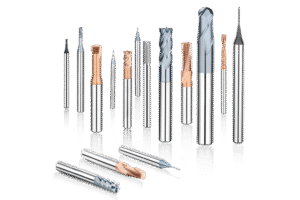
Guide to Selecting End Mill Coatings for Different Materials
Different materials impose different demands on tool coatings. Choosing the right end mill coating improves machining efficiency, extends tool life, and reduces overall production costs. Below are coating recommendations for common materials in CNC high-speed machining.
End Mill Coatings for Aluminum
Aluminum often causes material sticking and tool clogging. Coatings such as TiB2 and DLC reduce friction and prevent buildup on the cutting edge. In high-speed aluminum machining, combining these coatings with optimized cutting parameters improves surface finish, reduces burrs, and maintains dimensional accuracy. Coolant strategies—liquid or air—further stabilize the process.
End Mill Coatings for Plastics
Plastic machining presents risks of melting, stringing, and poor surface finish. Low-friction coatings like TiN or specialized anti-stick layers minimize adhesion between tool and workpiece. At high speeds, coated tools combined with controlled cutting temperatures maintain smooth surfaces and reduce tool wear, ensuring cost-effective machining.
End Mill Coatings for Steel
Steel requires coatings with high hardness and heat resistance. TiAlN and AlTiN coatings excel in reducing wear and preventing edge chipping under high-speed conditions. Engineers often pair coated tools with optimized cutting depths, feed rates, and cooling systems to maximize tool life and maintain surface precision.
End Mill Coatings for Stainless Steel
Stainless steel tends to cause work hardening, galling, and tool wear. Coatings like AlTiN and TiAlN withstand high cutting temperatures and reduce friction. By fine-tuning cutting parameters and applying proper coolant, engineers can overcome work hardening and achieve stable, high-quality machining results.
End Mill Coatings for Titanium
Titanium is notoriously difficult to machine due to heat buildup and tool wear. Coatings with superior thermal stability—such as AlTiN or diamond coatings—are essential. When paired with optimized cutting parameters, these coatings improve tool life, cutting efficiency, and workpiece accuracy, which is critical in aerospace and medical applications.

Practical Tips for End Mill Coatings in High-Speed Machining
Even with the right coating, machining success depends on parameter optimization, surface control, and tool maintenance. Proper application of coated tools maximizes performance and ensures long-term cost savings.
Optimizing Cutting Parameters for Coated Tools
The effectiveness of coated tools depends on matching cutting parameters to both material and coating type. For example, aluminum machining benefits from higher spindle speeds and feed rates with TiB2 coatings, while steel or stainless steel requires controlled cutting depths to prevent heat-induced tool wear. By leveraging the strengths of coatings like TiAlN, AlTiN, or TiB2, CNC engineers can achieve both productivity and tool longevity.
The Impact of Coatings on Surface Quality
Workpiece surface roughness is closely linked to coating type. Low-friction coatings such as TiB2 and TiN minimize material adhesion in aluminum and plastics, producing smooth finishes. Heat-resistant coatings like AlTiN maintain edge sharpness in titanium and steel, ensuring precise surfaces. Choosing the right coating reduces post-processing costs like polishing or surface treatment.
Coated Tool Maintenance and Life Management
Even advanced coatings wear over time. To extend tool life:
-
Clean tools regularly to avoid residue buildup.
-
Monitor wear and adjust parameters before failure occurs.
-
Use recoating services when the substrate is still viable.
-
Establish replacement schedules tailored to each material type.
These strategies keep tools performing at their best, reduce procurement costs, and ensure consistent high-speed machining results.

Future Trends and Innovations in Milling Cutter Coatings
With the rise of intelligent manufacturing and precision machining, milling cutter coating technology is shifting toward higher performance, longer tool life, and greater environmental sustainability. Traditional single-layer coatings can no longer fully meet the demands of high-speed machining, difficult-to-machine materials, and superior surface finish. Future innovation will focus on advanced composite coating materials, integration with smart manufacturing, and coatings that balance wear resistance, heat resistance, and low friction. For CNC machining companies, staying updated with the latest coating developments not only reduces tooling costs but also improves machining stability and overall productivity.
New Composite Coating Materials
Recent years have seen rapid progress in nanocoatings and diamond-based coatings. Nanostructured coatings refine the grain size, enhancing both wear resistance and high-temperature stability. These are particularly effective for high-speed steel and carbide end mills used in cutting steel, stainless steel, and titanium alloys.
On the other hand, CVD diamond coatings and PCD tools provide outstanding anti-adhesion properties and extremely long service life, especially in high-speed dry cutting of graphite, CFRP composites, and aluminum alloys. The next generation of coatings will likely combine multiple advantages—such as hardness, thermal stability, and low friction—into a single composite layer, designed to meet the complex requirements of aerospace, medical devices, and new energy component machining.
The Impact of High-Speed Machining on Coating Technology
In high-speed cutting environments, coatings must deliver not only superior hardness and thermal resistance but also compatibility with intelligent manufacturing systems. For example, automated CNC machines combined with real-time tool wear monitoring and life prediction models can significantly reduce downtime and maximize productivity.
In addition, the growing push toward green manufacturing is driving the adoption of dry cutting and MQL. This trend requires coatings that maintain excellent cutting performance even without conventional coolant.
Looking forward, breakthroughs in materials science will merge with technologies such as intelligent sensing and digital twins, paving the way for adaptive tooling solutions. These advancements will enhance automation, reliability, and machining efficiency in high-demand industries.

Summary and Recommendations for CNC Engineers
In CNC machining, the choice of milling cutter coatings directly affects cutting efficiency, tool life, and workpiece surface quality. Different materials require coatings with specific properties:
-
Aluminum machining benefits from low-friction, anti-stick coatings such as TiB₂.
-
Plastic machining requires coatings with strong heat resistance to prevent melting.
-
Steel and stainless steel perform best with hard, wear-resistant coatings like AlTiN or TiAlN.
-
Titanium alloys demand high-temperature stable coatings for consistent performance.
In high-speed machining, coatings not only boost productivity but also play a critical role in cost control. By optimizing cutting parameters—feed rate, depth of cut, and spindle speed—CNC engineers can maximize the performance of coated tools, reduce wear, and extend tool life. Regular cleaning, recoating, and preventive maintenance further ensure stable and cost-effective production.
Future trends in nanocoatings, diamond coatings, and composite coatings will bring new opportunities for CNC machining. As smart manufacturing and digital workshops expand, engineers must master both coating selection and its integration with machining strategies. Doing so allows manufacturers to cut costs, improve efficiency, and stay competitive in industries such as aerospace, automotive, and mold manufacturing.
CNC Engineers’ Recommendations
-
Select coatings based on material properties – Avoid a one-size-fits-all approach. Match the coating to the workpiece material and machining objectives.
-
Optimize parameters for coated tools – Adjust spindle speeds and feeds to maximize coating performance in high-speed machining.
-
Maintain and recoat tools regularly – Proper cleaning and recoating extend tool life and reduce long-term costs.
-
Stay informed about new technologies – Track industry applications of nanocoatings, diamond coatings, and composite coatings to maintain a competitive advantage.




